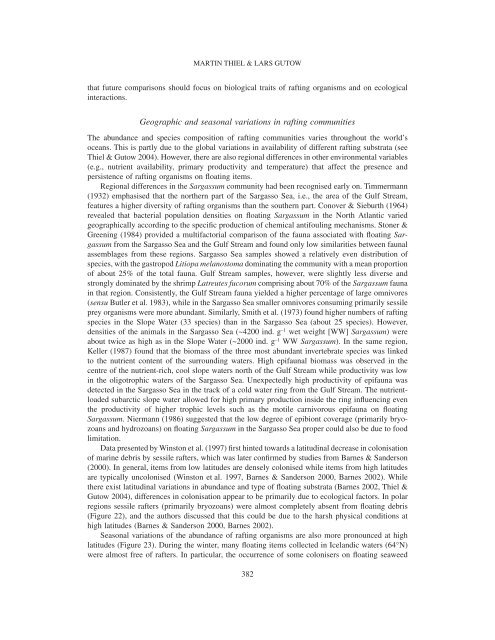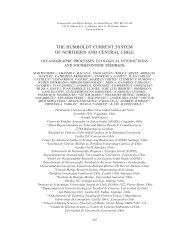The ecology of rafting in the marine environment - Bedim
The ecology of rafting in the marine environment - Bedim
The ecology of rafting in the marine environment - Bedim
You also want an ePaper? Increase the reach of your titles
YUMPU automatically turns print PDFs into web optimized ePapers that Google loves.
MARTIN THIEL & LARS GUTOW<br />
that future comparisons should focus on biological traits <strong>of</strong> <strong>raft<strong>in</strong>g</strong> organisms and on ecological<br />
<strong>in</strong>teractions.<br />
Geographic and seasonal variations <strong>in</strong> <strong>raft<strong>in</strong>g</strong> communities<br />
<strong>The</strong> abundance and species composition <strong>of</strong> <strong>raft<strong>in</strong>g</strong> communities varies throughout <strong>the</strong> world’s<br />
oceans. This is partly due to <strong>the</strong> global variations <strong>in</strong> availability <strong>of</strong> different <strong>raft<strong>in</strong>g</strong> substrata (see<br />
Thiel & Gutow 2004). However, <strong>the</strong>re are also regional differences <strong>in</strong> o<strong>the</strong>r <strong>environment</strong>al variables<br />
(e.g., nutrient availability, primary productivity and temperature) that affect <strong>the</strong> presence and<br />
persistence <strong>of</strong> <strong>raft<strong>in</strong>g</strong> organisms on float<strong>in</strong>g items.<br />
Regional differences <strong>in</strong> <strong>the</strong> Sargassum community had been recognised early on. Timmermann<br />
(1932) emphasised that <strong>the</strong> nor<strong>the</strong>rn part <strong>of</strong> <strong>the</strong> Sargasso Sea, i.e., <strong>the</strong> area <strong>of</strong> <strong>the</strong> Gulf Stream,<br />
features a higher diversity <strong>of</strong> <strong>raft<strong>in</strong>g</strong> organisms than <strong>the</strong> sou<strong>the</strong>rn part. Conover & Sieburth (1964)<br />
revealed that bacterial population densities on float<strong>in</strong>g Sargassum <strong>in</strong> <strong>the</strong> North Atlantic varied<br />
geographically accord<strong>in</strong>g to <strong>the</strong> specific production <strong>of</strong> chemical antifoul<strong>in</strong>g mechanisms. Stoner &<br />
Green<strong>in</strong>g (1984) provided a multifactorial comparison <strong>of</strong> <strong>the</strong> fauna associated with float<strong>in</strong>g Sargassum<br />
from <strong>the</strong> Sargasso Sea and <strong>the</strong> Gulf Stream and found only low similarities between faunal<br />
assemblages from <strong>the</strong>se regions. Sargasso Sea samples showed a relatively even distribution <strong>of</strong><br />
species, with <strong>the</strong> gastropod Litiopa melanostoma dom<strong>in</strong>at<strong>in</strong>g <strong>the</strong> community with a mean proportion<br />
<strong>of</strong> about 25% <strong>of</strong> <strong>the</strong> total fauna. Gulf Stream samples, however, were slightly less diverse and<br />
strongly dom<strong>in</strong>ated by <strong>the</strong> shrimp Latreutes fucorum compris<strong>in</strong>g about 70% <strong>of</strong> <strong>the</strong> Sargassum fauna<br />
<strong>in</strong> that region. Consistently, <strong>the</strong> Gulf Stream fauna yielded a higher percentage <strong>of</strong> large omnivores<br />
(sensu Butler et al. 1983), while <strong>in</strong> <strong>the</strong> Sargasso Sea smaller omnivores consum<strong>in</strong>g primarily sessile<br />
prey organisms were more abundant. Similarly, Smith et al. (1973) found higher numbers <strong>of</strong> <strong>raft<strong>in</strong>g</strong><br />
species <strong>in</strong> <strong>the</strong> Slope Water (33 species) than <strong>in</strong> <strong>the</strong> Sargasso Sea (about 25 species). However,<br />
densities <strong>of</strong> <strong>the</strong> animals <strong>in</strong> <strong>the</strong> Sargasso Sea (~4200 <strong>in</strong>d. g –1 wet weight [WW] Sargassum) were<br />
about twice as high as <strong>in</strong> <strong>the</strong> Slope Water (~2000 <strong>in</strong>d. g –1 WW Sargassum). In <strong>the</strong> same region,<br />
Keller (1987) found that <strong>the</strong> biomass <strong>of</strong> <strong>the</strong> three most abundant <strong>in</strong>vertebrate species was l<strong>in</strong>ked<br />
to <strong>the</strong> nutrient content <strong>of</strong> <strong>the</strong> surround<strong>in</strong>g waters. High epifaunal biomass was observed <strong>in</strong> <strong>the</strong><br />
centre <strong>of</strong> <strong>the</strong> nutrient-rich, cool slope waters north <strong>of</strong> <strong>the</strong> Gulf Stream while productivity was low<br />
<strong>in</strong> <strong>the</strong> oligotrophic waters <strong>of</strong> <strong>the</strong> Sargasso Sea. Unexpectedly high productivity <strong>of</strong> epifauna was<br />
detected <strong>in</strong> <strong>the</strong> Sargasso Sea <strong>in</strong> <strong>the</strong> track <strong>of</strong> a cold water r<strong>in</strong>g from <strong>the</strong> Gulf Stream. <strong>The</strong> nutrientloaded<br />
subarctic slope water allowed for high primary production <strong>in</strong>side <strong>the</strong> r<strong>in</strong>g <strong>in</strong>fluenc<strong>in</strong>g even<br />
<strong>the</strong> productivity <strong>of</strong> higher trophic levels such as <strong>the</strong> motile carnivorous epifauna on float<strong>in</strong>g<br />
Sargassum. Niermann (1986) suggested that <strong>the</strong> low degree <strong>of</strong> epibiont coverage (primarily bryozoans<br />
and hydrozoans) on float<strong>in</strong>g Sargassum <strong>in</strong> <strong>the</strong> Sargasso Sea proper could also be due to food<br />
limitation.<br />
Data presented by W<strong>in</strong>ston et al. (1997) first h<strong>in</strong>ted towards a latitud<strong>in</strong>al decrease <strong>in</strong> colonisation<br />
<strong>of</strong> mar<strong>in</strong>e debris by sessile rafters, which was later confirmed by studies from Barnes & Sanderson<br />
(2000). In general, items from low latitudes are densely colonised while items from high latitudes<br />
are typically uncolonised (W<strong>in</strong>ston et al. 1997, Barnes & Sanderson 2000, Barnes 2002). While<br />
<strong>the</strong>re exist latitud<strong>in</strong>al variations <strong>in</strong> abundance and type <strong>of</strong> float<strong>in</strong>g substrata (Barnes 2002, Thiel &<br />
Gutow 2004), differences <strong>in</strong> colonisation appear to be primarily due to ecological factors. In polar<br />
regions sessile rafters (primarily bryozoans) were almost completely absent from float<strong>in</strong>g debris<br />
(Figure 22), and <strong>the</strong> authors discussed that this could be due to <strong>the</strong> harsh physical conditions at<br />
high latitudes (Barnes & Sanderson 2000, Barnes 2002).<br />
Seasonal variations <strong>of</strong> <strong>the</strong> abundance <strong>of</strong> <strong>raft<strong>in</strong>g</strong> organisms are also more pronounced at high<br />
latitudes (Figure 23). Dur<strong>in</strong>g <strong>the</strong> w<strong>in</strong>ter, many float<strong>in</strong>g items collected <strong>in</strong> Icelandic waters (64°N)<br />
were almost free <strong>of</strong> rafters. In particular, <strong>the</strong> occurrence <strong>of</strong> some colonisers on float<strong>in</strong>g seaweed<br />
382










